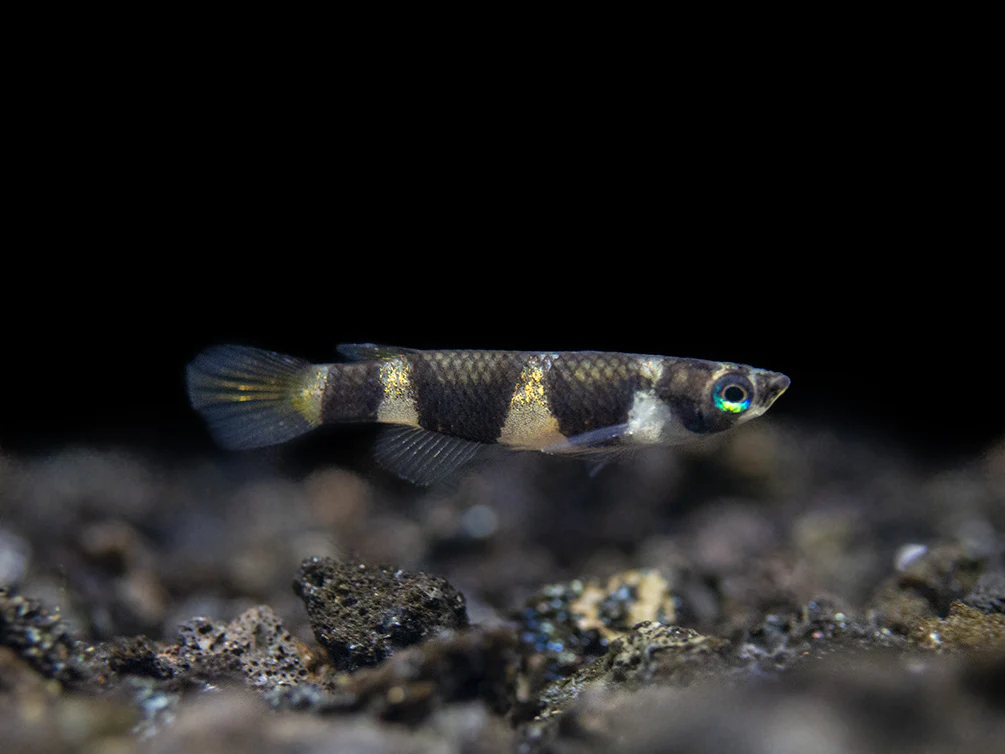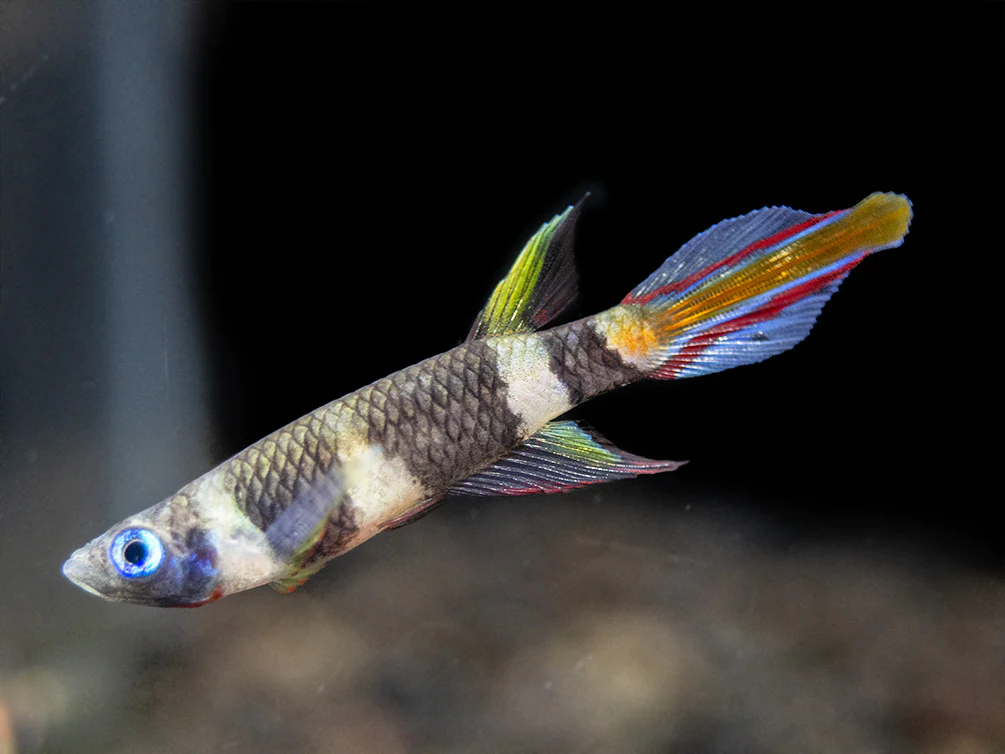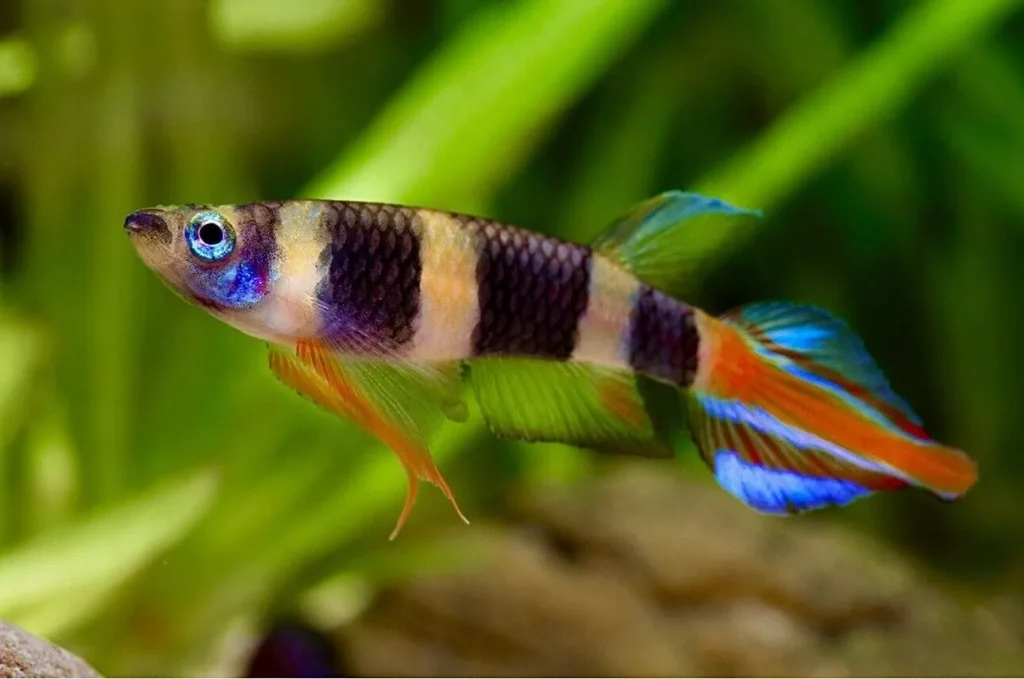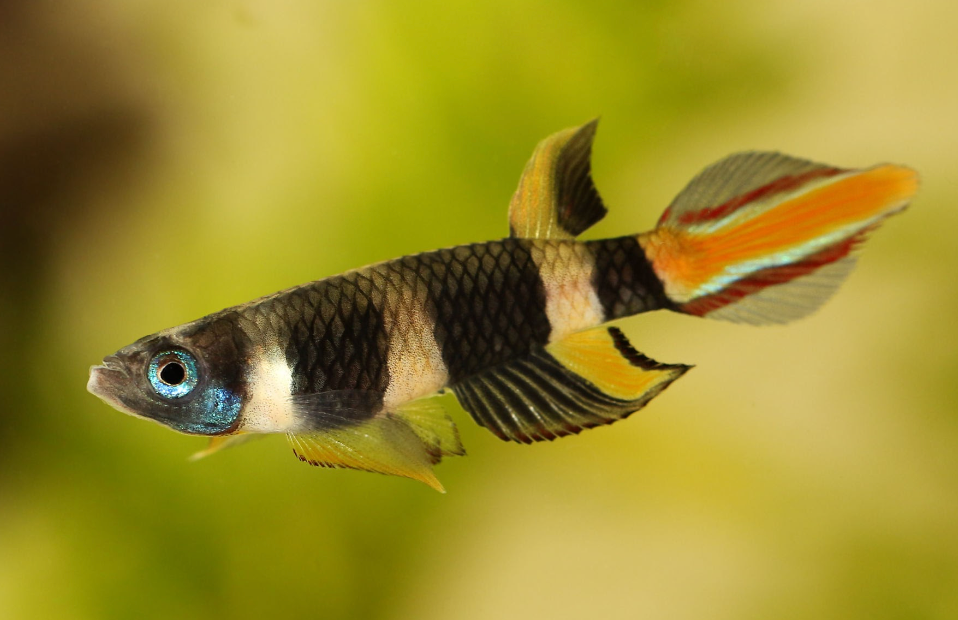Clown Killifish (Epiplatys annulatus)
Clown killifish (Epiplatys annulatus) are small, colorful fish that can make an interesting addition to your freshwater aquarium. While they are not the most common species within the hobby, these fish are becoming more and more popular. Clown killifish care requirements are not too difficult, and when provided with a proper setup they are a rewarding species to keep.
They are a nano fish from slow moving streams and swamps in West Africa, and their striped “clown” color pattern makes them truly unique. Clown killifish only grow to be about 1.5 inches long, and are a great choice for nano aquariums. You will need to keep at minimum a group of 3 clown killifish, however they will do best in a larger group. I’d recommend a group of 6 or more to reduce stress and encourage social behaviors.
Clown killifish are very docile and peaceful fish, and do well in community tanks with appropriate tankmates. In this guide, we will be covering all of the basic concepts you’ll want to know for proper clown killifish care, including feeding, tank setup, good tankmates, and more!
Clown Killifish Species Overview
Adult Size: 1.5 inches
Lifespan: 2 years
Diet: Micro Predator
Care Level: Easy-Moderate
Minimum Tank Size: 5 gallons
Temperature: 73-80°F (23-27°C)
pH: 5.5-7.0
Origin: West Africa
Clown Killifish Care
For the most part, clown killifish have easy care requirements and make a good fish for beginner aquarists. They tend to do best when provided with a heavily planted tank environment, as the waters they hail from have lots of aquatic vegetation. There are certain things you will want to look out for, however.
These fish will generally stay in the top area of the aquarium near the surface, and appreciate some floating plants which will allow them places to hide, like red root floater or dwarf water lettuce. You can distinguish the males from females due to the males having a much more vibrant color patterning in their fins, and the females fins being mostly devoid of color.


Feeding
Clown killifish are micro predators with very small mouths, and do best with a feeding program that is similar to their insect heavy diet in nature. I’d recommend mixing a floating insect based pellet with live or frozen baby brine shrimp or daphnia mixed in on occasion.
Clown killifish have small stomachs and can easily overeat, leading to health issues and water quality problems. Feed them only what they can consume in a few minutes, removing any uneaten food to prevent fouling the water.
Water Conditions
Clown killifish thrive in freshwater aquariums with water conditions that mimic their natural habitat. They prefer slightly acidic to neutral water with a pH range of 6.0 to 7.0. Maintaining pH within this range is crucial for their overall health and well-being. Leaf litter and drift wood may aid in keeping the water parameters at a pH that is suitable for killifish.
They can tolerate a moderate range of water hardness, but they generally prefer softer water with a hardness level between 5 to 15 dGH (degrees of General Hardness). Also look to ensure adequate oxygenation and gentle water flow in the aquarium, as clown killifish hail from oxygen rich waters in the wild.
Use caution when adding chemical additives to the water, as clown killifish can be sensitive to certain medications and water treatments. Always thoroughly research the compatibility of any additives with these fish before use.

Breeding
Breeding clown killifish is generally considered moderately challenging compared to some widely bred species like guppies or platies. While they don’t require highly specialized conditions, successful breeding often involves meticulous attention to water parameters and providing suitable spawning sites.
Under favorable conditions clown killifish are known to spawn frequently , which can be both rewarding and challenging for breeders. Managing multiple breeding cycles and ensuring adequate space and resources for fry can require dedication and quite a few tanks.
Clown killifish engage in elaborate courtship displays, including chasing and displaying their vibrant colors. Observing these behaviors indicates that spawning is imminent. The female will scatter her eggs shortly after breeding, and look to promptly remove the adult fish after spawning to prevent them from consuming the eggs.
The eggs typically hatch within 7 to 14 days, depending on water temperature and conditions. Maintain stable water parameters and provide gentle aeration to ensure the health of the developing fry. Once the fry hatch, feed them infusoria or commercial liquid fry food until they are large enough to accept newly hatched brine shrimp or other small live foods. Keep the water pristine to promote healthy growth.
Common Diseases and Health Issues
Clown killifish are generally hardy fish when provided with appropriate care, but like any aquarium fish, they can be susceptible to certain diseases and health issues. Some common diseases and health issues include:
- Fungal infections
- Bacterial infections
- Parasites
- Injuries
- Stress related issues
When first purchasing your clown killifish, I’d recommend quarantining them for at least a few days. If you notice one of these issues with your clown killifish, look to separate them and treat them with an appropriate antibiotic for the type of infection they’re dealing with. Maintaining a proper tank setup, with appropriate water conditions, plants, and tankmates will generally prevent injuries and stress related issues.
Clown Killifish Tank Setup
For clown killifish, you’ll want to provide at least a gallon tank at minimum. If you’re looking to keep a group of 6 or more as we’d recommend, a 10 gallon tank or larger will be more suitable. You’ll likely need an appropriately sized aquarium heater, as clown killifish do best at temperatures of 73-80°F (23-27°C).
Clown killifish prefer slow to moderate water flow. Use a gentle filter such as a sponge filter to avoid strong currents, as they inhabit slow-moving waters in the wild. To mimic their natural environment, a sandy substrate is preferable, but an aquasoil that helps regulate pH may also work well.
As mentioned previously, aquatic wood and leaf litter will help to create the proper water conditions, but will also help to emulate their natural environment and help them feel at home.
Tankmates
Clown killifish are very docile and pair well with other non-aggressive community fish that are similar in size and have similar water condition requirements. Avoid keeping them with larger or aggressive species. With killifish being a top dwelling species, they do well with bottom to mid tank dwelling fish like catfish.
Some fish that do well in a community tank with clown killifish include:
- Other killifish
- Panda corydoras (Or other cory catfish)
- Otocinclus catfish
- Harlequin rasbora (Or other rasbora)
Be sure not to overstock your aquarium, we’d recommend checking out an aquarium stocking calculator such as aqadvisor.com to help gauge the stocking level of your tank.
Clown Killifish Care Summary
Keeping clown killifish in a freshwater aquarium offers aquarists a delightful opportunity to care for and observe these captivating creatures. Their vibrant colors, unique behaviors, and relatively straightforward care requirements make them an appealing choice for both beginner and experienced hobbyists alike. Originating from slow-moving streams and swamps in West Africa, clown killifish thrive in well-planted community tanks and have become a personal favorite of ours here at LeafyAquatics.

